Early Verdict
The Patriot Hellfire M.2 delivers higher performance than the Zotac Sonix add-in card but still comes up short in a few workloads that hurt the overall product. If you are looking for high-speed storage for your desktop, something that goes above and beyond what SATA can offer, this may be a good NVMe entry-level, low-cost choice. Pricing will determine where this drive falls in the NVMe hierarchy, and we expect a strong showing if Patriot reduces the price.
Pros
- +
High performance
- +
Pricing should be attractive
- +
A new frontier of entry-level NVMe
Cons
- -
Notebook battery life performance
- -
Software deficiency (there is none)
- -
Low random read performance
Why you can trust Tom's Hardware
Specifications & Features
Patriot began teasing us with its Hellfire NVMe SSDs in January. At each major trade show, we saw the Hellfire evolve into the retail product that is now coming to market. The first Hellfire SSDs to achieve liftoff are the M.2 products in 240GB and 480GB capacities, and add-in card (AIC) models will follow. The Hellfire promises a blistering 3 / 2.2 GB/s of sequential read/write throughput and boasts equally impressive random performance. We test the Phison PS5007-E7 NVMe powered SSD to see how it compares with other 512GB SSDs.
The Phison PS5007-E7 controller originally came to life with release candidate firmware on the Zotac Sonix 480GB add-in-card earlier this summer. In the interim, Phison made several changes to the firmware, and Patriot Memory is the first company to bring an E7 to market with mass production firmware.
Two Hellfire products will make their way to market in the coming months. The M.2 2280 unit we have in hand leads the way, and later this year Patriot will release the AIC form factor that is nearing completion. We saw the final rendering of the Hellfire AIC at the Flash Memory Summit and walked away impressed. It is our understanding that Patriot is just waiting for the fashionable heat sinks to become available.
The Hellfire M.2 2280 is the first retail release with the Phison PS5007-E7 in the M.2 form factor. The small form factor poses significant thermal dissipation problems for SSD manufacturers. Add-in cards are larger than M.2’s, and thus have more area for thermal dissipation. The larger form factor also has the advantage of more PCB real estate, so there is ample room for a heat sink. In contrast, the smaller M.2 form factor doesn't have much room for a heat sink. Thermal throttling is one of the most pressing issues we've encountered with M.2 SSDs. Some products throttle performance (to stay within a safe temperature range) more than others, and even the same product may perform differently if you use it in a desktop with active cooling or a notebook with little airflow.
Technical Specifications
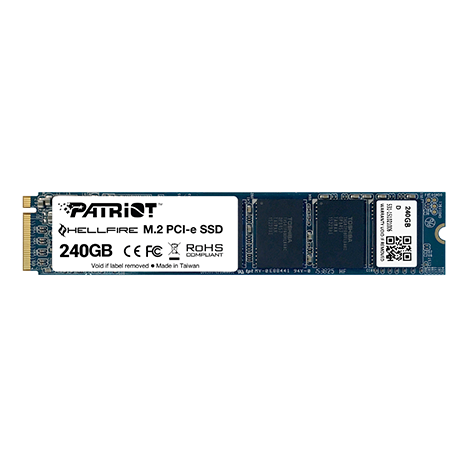
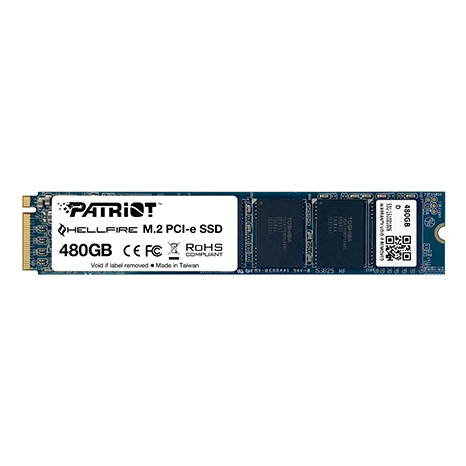
As mentioned, the Patriot Memory Hellfire M.2 utilizes an 8-channel Phison PS5007-E7 flash processor. Patriot married the controller to Toshiba planar 15nm MLC NAND flash and a low-power DDR3 DRAM buffer. Patriot released 240GB and 480GB Hellfire SSDs at launch, but at the time of writing, Newegg and Amazon didn't have the drive in stock. We expect retail availability by the time you read this.
At Computex 2016 this past June, Patriot displayed a 1TB Hellfire M.2 SSD that utilized a 22110 form factor, but the drive has yet to come to market. 22110 could work in a notebook, but we have not encountered that much space for an M.2 in a notebook yet. Desktop motherboards with M.2 slots sandwiched between PCI Express slots support the extended form factor.
Patriot used off-the-shelf test tools (we call these one-click benchmarks) like ATTO and Crystal Disk Mark to show performance. Most of these tools do not run with multiple workers, so the results are very close to our own testing. The Hellfire M.2 SSDs deliver up to 3,000 MB/s sequential read and 2,200 MB/s of sequential write speed. Random performance reaches up to 130,000 IOPS read and up to 210,000 IOPS write. The 240GB Hellfire delivers slightly higher random read performance and the 480GB model provides slightly better random write performance.
Get Tom's Hardware's best news and in-depth reviews, straight to your inbox.
Phison has yet to release an NVMe driver for any of the E7-based products. We've spoken with Phison previously about the driver situation, and the company seems to feel the Microsoft driver is adequate. Both Intel and Samsung have released product-specific NVMe drivers to provide increased performance with their SSDs. Most performance gains come in the form of decreased read and write latency.
Features
Controller Highlights
- Compatible with PCI Express Rev. 3.0
- NVMe 1.2 Specification
- Backward Compatible with PCIe 1 and 2
- Support for 2Gb and 4Gb DDR3 DRAM
- 120bit/2KB ECC BCH
- Program RAM
- SmartECC Technology
- SmartFlush Technology
- GuaranteedFlush Technology
- Static and Dynamic Wear-Leveling
- L1.2 Power Saving Mode
- End-to-End Data Path Protection
Pricing, Warranty And Accessories
The Hellfire M.2 SSDs were not available at online retailers at the time of writing. Patriot Memory's website lists the MSRP for the 240GB model at $169.99 and the 480GB model at $319.99. SSDs rarely sell at MSRP for more than a month. The Zotac Sonix sold at the MSRP ($369.99) for a few weeks but now sells for $279.99 at Newegg.
The Hellfire M.2 series carries a 3-year warranty that Patriot limits by the total bytes written (TBW) to the drive (commonly measured in terabytes). The 240GB allows for 115 TBW, and the 480GB doubles that to 230 TBW.
The drive ships in a blister pack that is void of any accessories. We scouted Patriot's website to find links to software downloads, for instance, management software or Acronis TrueImage HD but didn't find any.
A Closer Look
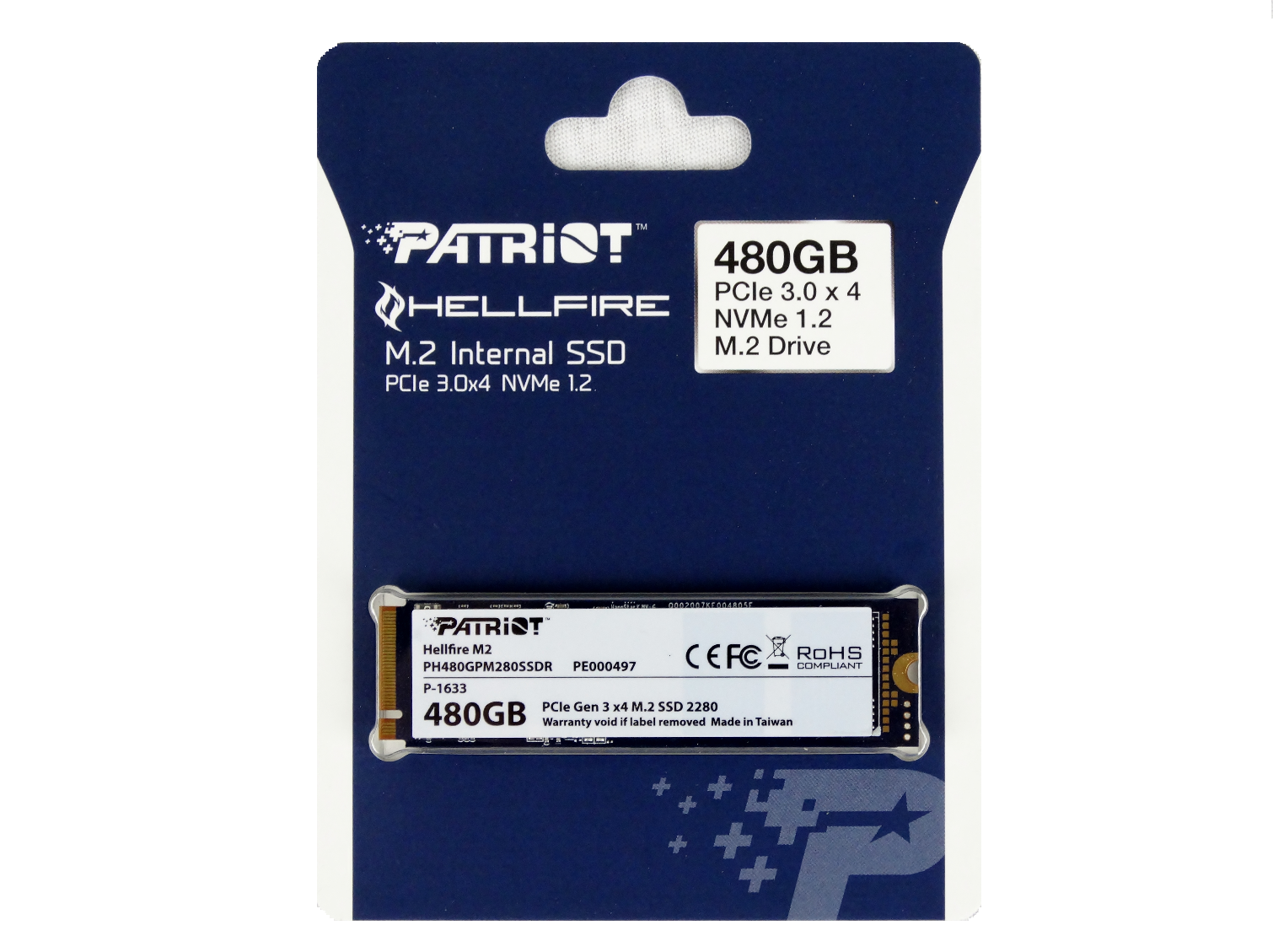
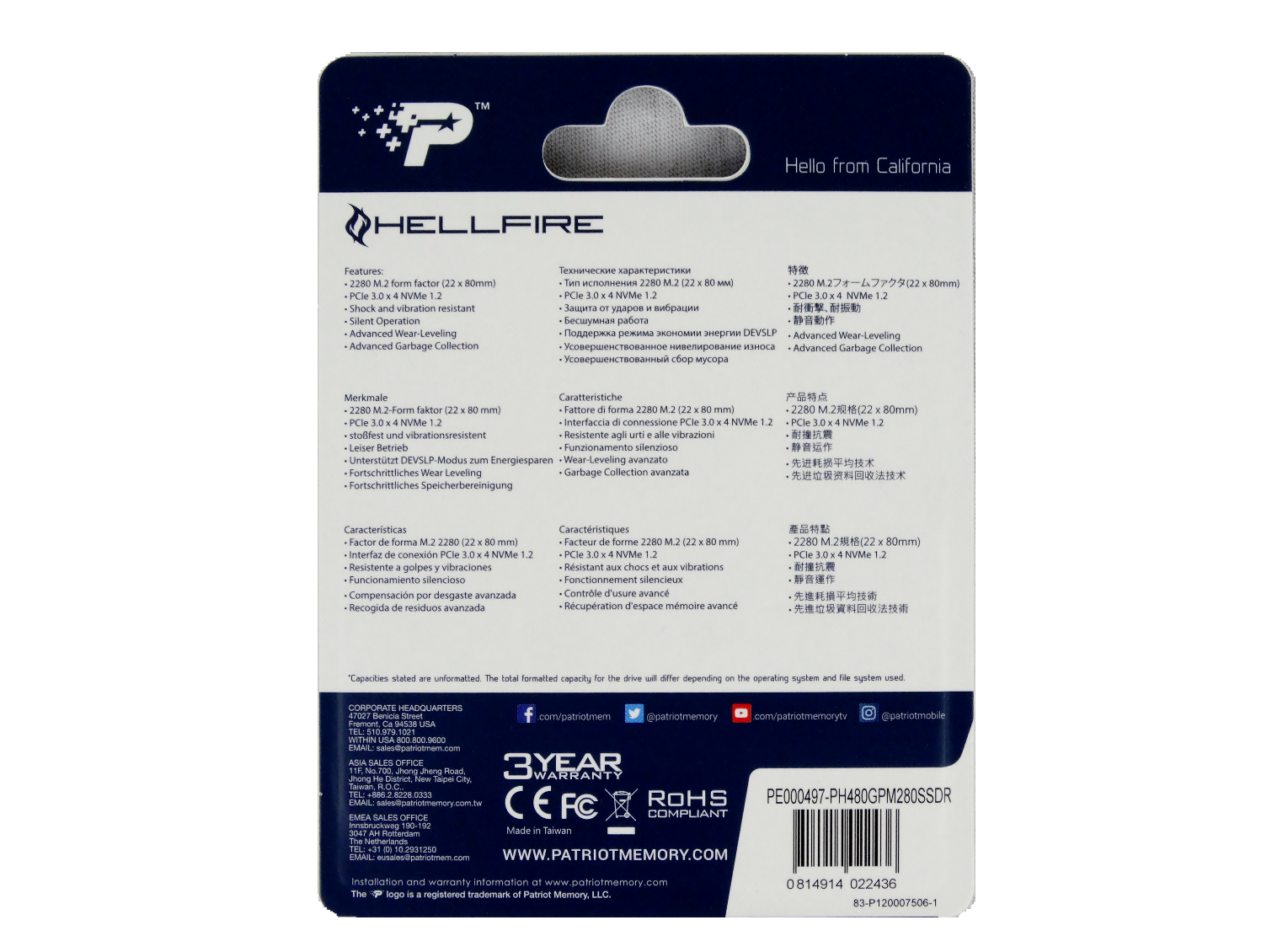



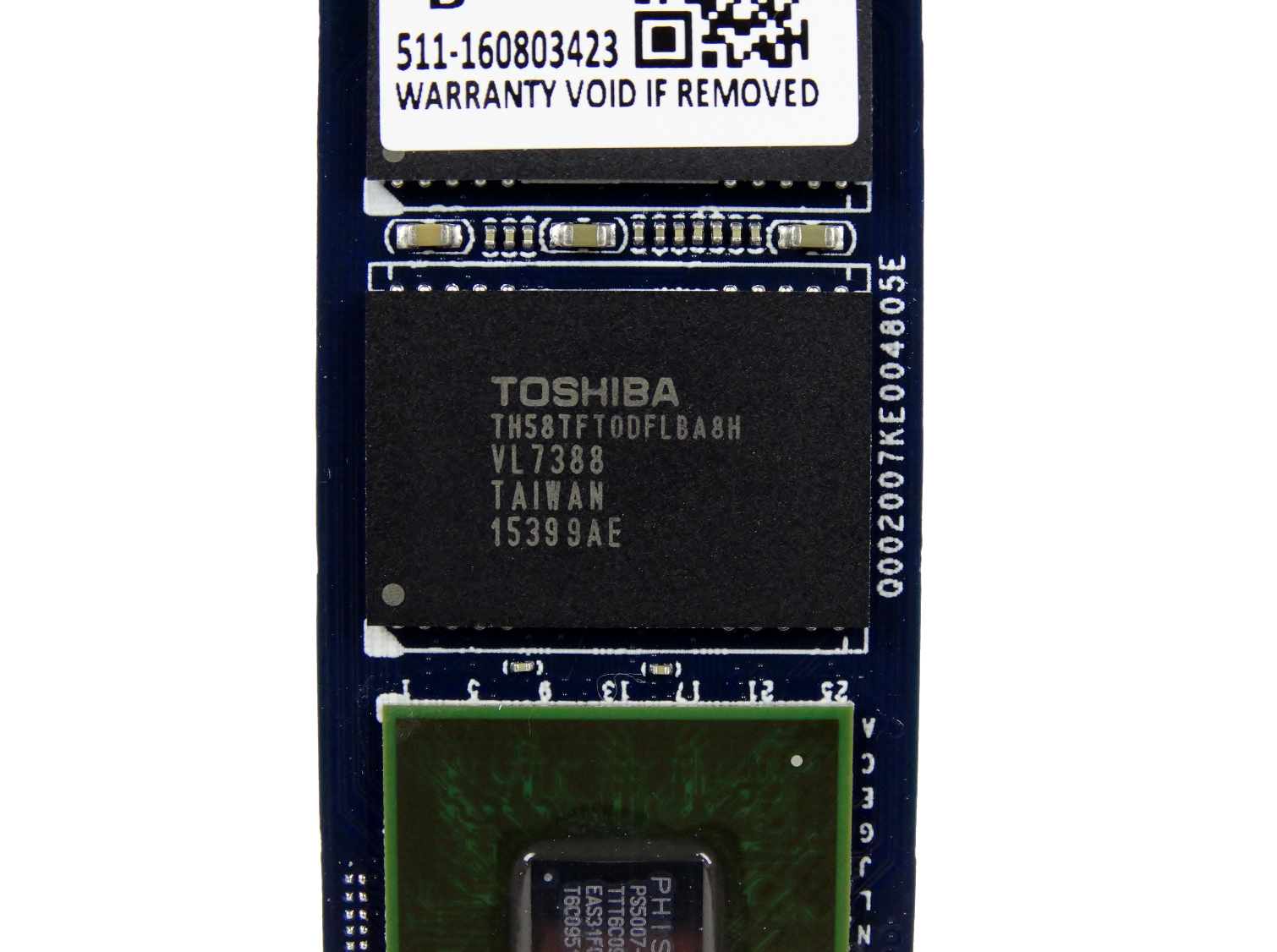
The Hellfire M.2 joins the Intel 600p as a new wave of low-cost NVMe SSDs make their way to market. Until now, any SSD using the NVMe protocol was very expensive. The Patriot Hellfire is more expensive than SATA-based AHCI SSDs are, but the price of NVMe SSDs have decreased greatly. To keep costs low, Patriot used a blister package to minimize manufacturing costs.
The drive is fairly basic. The most exciting aspect is the flip-chip controller design that we rarely see. SandForce would have released a similar flip-chip controller, but the product ran into trouble as the company ping-ponged through acquisitions before winding up as a new division at Seagate.
One aspect that may seem trivial is the Hellfire's dual-sided design. The 480GB model sports components on both sides of the printed circuit board but some notebooks don't allow for the extra girth.
MORE: Best SSDs
MORE: Latest Storage News
MORE: Storage in the Forums

Chris Ramseyer was a senior contributing editor for Tom's Hardware. He tested and reviewed consumer storage.
-
Ergosum Prices are so stubbornly high for PCIe storage! Is it an issue of not wanting to kill the SATA3 golden goose? Given the enclosure requirements of a SATA drive, you'd think that production costs would be significantly lower.Reply
Changing the subject a little, I've been very surprised at the dearth of reviews on the Intel 600p (at the time of this posting there is only one, from pcper). I hope we can get this review, and maybe an update to the best for your money article for storage. Thanks! -
joex444 > The Hellfire M.2 480GB matches the Samsung 950 Pro 512GB at queue depth 2 and then runs away from all but the Intel SSD 750 400GB in sequential mixed workloads with 80-percent reads.Reply
Intel -> OCZ, since it's the green line not the black one. Or the chart is incorrect. -
Brian_R170 "The Hellfire M.2 joins the Intel 600p as a new wave of low-cost NVMe SSDs make their way to market."Reply
The "low-cost" 512GB Hellfire M.2 MSRP is $319.99 compared to the "expensivie" 512GB Samsung 950 Pro MSRP of $349. Is an 8.6% difference in MSRP really considered some other low-cost tier or is this comment purely based on wishful thinking that the device will have a $270 price some time in the future?
The Intel 600p doesn't seem like any type of performance king, but at least there's a significant cost savings compared to a $318 street price of the 950 Pro. I bought the 512GB for $190 the day it came out and I saw it today on Newegg marketplace for $174. -
razor512 It is pretty much price gouging, as the production cost for these NVMe devices is lower than that of SATA.Reply -
CRamseyer Let me give you guys a few updates. First let's cover Hellfire. Patriot gets a new firmware around the 16th. The firmware takes this series up to 2.1. We tested with 2.0. I've seen the numbers from 2.1 and it looks really good. We are going to save the Hellfire 240GB for the update and retest the 480GB drive in this review. YOu may ask why we didn't do that to start with. The answer is we didn't know when we started the review or scheduled it.Reply
The Intel 600p is in our lab. We have both the 256GB and 512GB. I'm finished with testing and the review will be on the site before the end of the month.
Prior to the Intel going live we will publish the Samsung PM961 as a preview of the 960 EVO. Samsung brings so much to the table that we really need to see what the 960 EVO will lay down before judging any of the other low-cost NVMe products.
Back to the Hellfire and pricing. MSRPs are made to be broken! There is no way the Hellfire can sustain it's current pricing with the Intel 600p and 960 EVO that may come next month.
Look for a 512GB class NVMe showdown early next week with all of the drives you want to see compared. -
josejones SATA is obsolete now - get it off my new Z270 motherboard as I don't want to keep paying for old obsolete crap I don't want and will never use. SATA is now like VGA and that took like 10 years to get rid of.Reply
Also, NVMe 1.2 is bottom of the barrel - we want nothing less than NVMe 1.4. -
Paul Alcorn Reply18566622 said:Prices are so stubbornly high for PCIe storage! Is it an issue of not wanting to kill the SATA3 golden goose? Given the enclosure requirements of a SATA drive, you'd think that production costs would be significantly lower.
Good point. SATA is the moneymaker, volume is higher. The latest Trendfocus report pegs SATA at 78 percent of the client SSD market. -
ozonefree I hate and loath the name "Hellfire." That's an air-to-ground missile used to blow things up. Better they should have named it the Titantic or Charge of the Light Brigade...Reply -
CRamseyer That was a perfect setup comment to rub Paul.Reply
The Army just announced a change to the Hellfire name. It is now called a Note 7.
